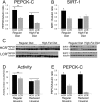Spontaneous activity, economy of activity, and resistance to diet-induced obesity in rats bred for high intrinsic aerobic capacity
- PMID: 20350549
- PMCID: PMC2923555
- DOI: 10.1016/j.yhbeh.2010.03.013
Spontaneous activity, economy of activity, and resistance to diet-induced obesity in rats bred for high intrinsic aerobic capacity
Abstract
Though obesity is common, some people remain resistant to weight gain even in an obesogenic environment. The propensity to remain lean may be partly associated with high endurance capacity along with high spontaneous physical activity and the energy expenditure of activity, called non-exercise activity thermogenesis (NEAT). Previous studies have shown that high-capacity running rats (HCR) are lean compared to low-capacity runners (LCR), which are susceptible to cardiovascular disease and metabolic syndrome. Here, we examine the effect of diet on spontaneous activity and NEAT, as well as potential mechanisms underlying these traits, in rats selectively bred for high or low intrinsic aerobic endurance capacity. Compared to LCR, HCR were resistant to the sizeable increases in body mass and fat mass induced by a high-fat diet; HCR also had lower levels of circulating leptin. HCR were consistently more active than LCR, and had lower fuel economy of activity, regardless of diet. Nonetheless, both HCR and LCR showed a similar decrease in daily activity levels after high-fat feeding, as well as decreases in hypothalamic orexin-A content. The HCR were more sensitive to the NEAT-activating effects of intra-paraventricular orexin-A compared to LCR, especially after high-fat feeding. Lastly, levels of cytosolic phosphoenolpyruvate carboxykinase (PEPCK-C) in the skeletal muscle of HCR were consistently higher than LCR, and the high-fat diet decreased skeletal muscle PEPCK-C in both groups of rats. Differences in muscle PEPCK were not secondary to the differing amount of activity. This suggests the possibility that intrinsic differences in physical activity levels may originate at the level of the skeletal muscle, which could alter brain responsiveness to neuropeptides and other factors that regulate spontaneous daily activity and NEAT.
Copyright 2010 Elsevier Inc. All rights reserved.
Figures





Comment in
-
Aerobic capacity muscles its way into the energy balance equation.Horm Behav. 2010 Aug;58(3):353-4. doi: 10.1016/j.yhbeh.2010.04.001. Epub 2010 Apr 9. Horm Behav. 2010. PMID: 20382148 No abstract available.
Similar articles
-
Voluntary Running Attenuates Metabolic Dysfunction in Ovariectomized Low-Fit Rats.Med Sci Sports Exerc. 2017 Feb;49(2):254-264. doi: 10.1249/MSS.0000000000001101. Med Sci Sports Exerc. 2017. PMID: 27669449 Free PMC article.
-
Ovariectomized Highly Fit Rats Are Protected against Diet-Induced Insulin Resistance.Med Sci Sports Exerc. 2016 Jul;48(7):1259-69. doi: 10.1249/MSS.0000000000000898. Med Sci Sports Exerc. 2016. PMID: 26885638 Free PMC article.
-
Intrinsic High Aerobic Capacity in Male Rats Protects Against Diet-Induced Insulin Resistance.Endocrinology. 2019 May 1;160(5):1179-1192. doi: 10.1210/en.2019-00118. Endocrinology. 2019. PMID: 31144719 Free PMC article.
-
Brain orexin promotes obesity resistance.Ann N Y Acad Sci. 2012 Aug;1264(1):72-86. doi: 10.1111/j.1749-6632.2012.06585.x. Epub 2012 Jul 17. Ann N Y Acad Sci. 2012. PMID: 22803681 Free PMC article. Review.
-
Feeding the heat on brown fat.Ann N Y Acad Sci. 2013 Oct;1302:11-23. doi: 10.1111/nyas.12276. Epub 2013 Sep 23. Ann N Y Acad Sci. 2013. PMID: 24111875 Review.
Cited by
-
Relationship of the Chemokine, CXCL12, to Effects of Dietary Fat on Feeding-Related Behaviors and Hypothalamic Neuropeptide Systems.Front Behav Neurosci. 2016 Mar 21;10:51. doi: 10.3389/fnbeh.2016.00051. eCollection 2016. Front Behav Neurosci. 2016. PMID: 27047354 Free PMC article.
-
Continuous Aerobic Training in Individualized Intensity Avoids Spontaneous Physical Activity Decline and Improves MCT1 Expression in Oxidative Muscle of Swimming Rats.Front Physiol. 2016 Apr 18;7:132. doi: 10.3389/fphys.2016.00132. eCollection 2016. Front Physiol. 2016. PMID: 27148071 Free PMC article.
-
Gene expression centroids that link with low intrinsic aerobic exercise capacity and complex disease risk.FASEB J. 2010 Nov;24(11):4565-74. doi: 10.1096/fj.10-157313. Epub 2010 Jul 19. FASEB J. 2010. PMID: 20643908 Free PMC article.
-
Role of the locus coeruleus in enhanced orexin A-induced spontaneous physical activity in obesity-resistant rats.Am J Physiol Regul Integr Comp Physiol. 2013 Dec;305(11):R1337-45. doi: 10.1152/ajpregu.00229.2013. Epub 2013 Oct 2. Am J Physiol Regul Integr Comp Physiol. 2013. PMID: 24089383 Free PMC article.
-
Nucleus accumbens cocaine-amphetamine regulated transcript mediates food intake during novelty conflict.Physiol Behav. 2016 May 1;158:76-84. doi: 10.1016/j.physbeh.2016.02.035. Epub 2016 Feb 27. Physiol Behav. 2016. PMID: 26926827 Free PMC article.
References
-
- Arch JR, Hislop D, Wang SJ, Speakman JR. Some mathematical and technical issues in the measurement and interpretation of open-circuit indirect calorimetry in small animals. Int J Obes (Lond) 2006;30(9):1322–1331. - PubMed
-
- Azzout-Marniche D, Gaudichon C, Blouet C, Bos C, Mathe V, Huneau JF, Tome D. Liver glyconeogenesis: a pathway to cope with postprandial amino acid excess in high-protein fed rats? Am J Physiol Regul Integr Comp Physiol. 2007;292(4):R1400–1407. - PubMed
-
- Backberg M, Hervieu G, Wilson S, Meister B. Orexin receptor-1 (OX-R1) immunoreactivity in chemically identified neurons of the hypothalamus: focus on orexin targets involved in control of food and water intake. Eur J Neurosci. 2002;15(2):315–328. - PubMed
-
- Bjursell M, Gerdin AK, Lelliott CJ, Egecioglu E, Elmgren A, Tornell J, Oscarsson J, Bohlooly YM. Acutely reduced locomotor activity is a major contributor to Western diet-induced obesity in mice. Am J Physiol Endocrinol Metab. 2008;294(2):E251–260. - PubMed
-
- Britton SL, Koch LG. Animal genetic models for complex traits of physical capacity. Exerc Sport Sci Rev. 2001;29(1):7–14. - PubMed
Publication types
MeSH terms
Substances
Grants and funding
- RR17718/RR/NCRR NIH HHS/United States
- 5T32HD007422-19/HD/NICHD NIH HHS/United States
- R01 NS055859/NS/NINDS NIH HHS/United States
- DK63226/DK/NIDDK NIH HHS/United States
- R01 DK066270/DK/NIDDK NIH HHS/United States
- R01 DK056650/DK/NIDDK NIH HHS/United States
- R01 DK063226/DK/NIDDK NIH HHS/United States
- R24 RR017718/RR/NCRR NIH HHS/United States
- UL1 RR024986/RR/NCRR NIH HHS/United States
- DK66270/DK/NIDDK NIH HHS/United States
- P01 DA021633/DA/NIDA NIH HHS/United States
- R04-0771/PHS HHS/United States
- UL1RR024986/RR/NCRR NIH HHS/United States
- DK56650/DK/NIDDK NIH HHS/United States
- T32 HD007422/HD/NICHD NIH HHS/United States
LinkOut - more resources
Full Text Sources
Medical

